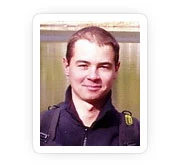Yoga Anatomy: Shoulder Kinematics in Yoga, Part 1

The shoulder is the most mobile joint in the body. It is a combination of several articulations: the glenohumeral, scapulothoracic, sternoclavicular and acromioclavicular joints. Each of these contributes to shoulder and arm movement via a process known as joint “coupling.” For example, when you raise your arms over your head in Urdhva Hastasana (Upward Hands Pose), the clavicle pivots on the sternum (breastbone), the scapula rotates on the chest wall, and the head of the humerus moves within the shoulder joint. All of these work together simultaneously in what is known as scapulohumeral rhythm.
In general, 60 degrees of this action comes from the movement of the shoulder blade on the chest wall (scapulothoracic motion) and 120 degrees from the ball and socket of the shoulder (glenohumeral motion). During this process, the clavicle rotates on its long axis approximately 25 degrees and the humerus externally rotates about 45 degrees. Scapulohumeral rhythm is illustrated in the video below, with a breakdown of scapulo-thoracic and gleno-humeral contributions to the entire movement.
Scapulohumeral Rhythm
So we can see that the shoulder is a complex structure, with many factors contributing to movement, or potentially restricting it. It’s easier to understand a complex structure by breaking it down into its component parts and then reconstructing them into the whole. This gives a new understanding of their function. For the shoulder, we’ll begin by focusing on the skeletal anatomy of the glenohumeral joint.
Here’s the Anatomy
The glenohumeral joint is comprised of the humeral head and the glenoid fossa of the scapula, which forms a shallow ball-and-socket joint. The proximal humerus also has two protuberances to which the muscles of the rotator cuff attach. These are the greater and lesser tuberosities. To see the anatomy of the rotator cuff, click here.
Another important structure of the scapula is the acromion process. This shelf-like projection of bone forms a roof over the top of the glenohumeral joint. It is also the attachment site for the deltoid and part of the trapezius. The subacromial bursa lies between the acromion and the proximal humerus (the humeral head and the greater tuberosity). It is a sac-like structure that facilitates gliding of the greater tuberosity and tendons of the supraspinatus and infraspinatus muscles on the undersurface of the acromion. Additionally, there are the muscles that attach to, move and stabilize the scapula, namely the rhomboids, trapezius, serratus anterior and levator scapulae.

The greater tuberosity (1) The subacromial bursa (2) and acromion process (3)
This Brings Us To Subacromial Impingement
When the arm is raised, either to the side or in front of the body, the greater tuberosity can “impinge” on the undersurface of the acromion, compressing the subacromial bursa and irritating the supraspinatus tendon. This is more likely to happen if the humerus is internally rotated. Externally rotating the upper arm bone draws the greater tuberosity out of the way of the acromion and aids to prevent impingement. The acromion comes in several different shapes, ranging from flat to curved. Curved acromions have been associated with a greater incidence of subacromial impingement.

|
The first image shows impingement of the subacromial bursa with the humerus internally rotated. |
So What Does This Have To Do With Yoga?
The question has been raised as to whether persons with a curved acromion are limited in their ability to perform certain asanas. For example, the inference that appears to have entered the yogic nomenclature is that if you cannot bring your arms vertical in a pose like Urdhva Dhanurasana (Upward Bow Pose), you must have a curved (not a flat) acromion. This is generally incorrect. First, it is well established through many studies that a curved acromion does not affect the functional range of motion of a healthy shoulder. People with curved acromions can raise their arms overhead just as far as those with a flat acromion. Second, it is impossible to tell the shape of someone’s acromion process by observing them in a yoga pose. Acromial morphology is something that is determined with a specialized X-ray.
So to answer the question, “In a healthy shoulder, do curved acromions affect the ability to raise your arms overhead in a pose such as Urdhva Dhanurasana?” The answer is that this is unlikely. The scapula rotates to bring the acromion out of the way of the humerus for much of the range of movement. There are many other more likely explanations for this limitation, including tightness in various muscles or the capsule and ligaments about the shoulder as well as inflexibility in the thorax/ribcage.
How Do We Prevent Impingement?

Now let’s consider how this relates to actual practice. Particularly in Vinyasa, there is a tendency to do the same movement many times, which can lead to a repetitive stress injury, such as inflammation of the subacromial bursa and supraspinatus tendon—“rotator cuff syndrome” in the orthopedic nomenclature. You can help to avoid this by engaging the infraspinatus and teres minor muscles and, to a lesser extent, the deltoid. These muscles act to externally rotate the humerus and bring the greater tuberosity away from the undersurface of the acromion. We illustrate this movement here in Urdhva Hastasana. To read about the anatomy and to see this concept in action in Adho Mukha Svanasana (Downward-Facing Dog Pose) and Adho Mukha Vrksasana (Full Arm Balance), click here.
More shoulder anatomy from Ray Long MD and YogaUOnline – Shoulder Biomechanics in Yoga Part 1: The Subscapularis Muscle.
Study pelvic floor health with Leslie Howard and YogaUOnline: Surprising Truths about Pelvic Floor Disorders – And How Yoga Can Help.
Reprinted with permission from Daily Bandha.
Images courtesy of Daily Bandha.
 Author Ray Long MD FRCSC is a board-certified orthopedic surgeon and the founder of Bandha Yoga. Ray graduated from The University of Michigan Medical School with post-graduate training at Cornell University, McGill University, The University of Montreal and Florida Orthopedic Institute. He has studied hatha yoga for over twenty years, training extensively with B.K.S. Iyengar and other leading yoga masters.
Author Ray Long MD FRCSC is a board-certified orthopedic surgeon and the founder of Bandha Yoga. Ray graduated from The University of Michigan Medical School with post-graduate training at Cornell University, McGill University, The University of Montreal and Florida Orthopedic Institute. He has studied hatha yoga for over twenty years, training extensively with B.K.S. Iyengar and other leading yoga masters.
 3d Graphic Designer / Illustrator Chris Macivor has been involved in the field of digital content creation for well over ten years. He is a graduate of Etobicoke School of the Arts, Sheridan College and Seneca College. Chris considers himself to be equally artistic and technical in nature. As such his work has spanned many genres from film and television to video games and underwater imagery.
3d Graphic Designer / Illustrator Chris Macivor has been involved in the field of digital content creation for well over ten years. He is a graduate of Etobicoke School of the Arts, Sheridan College and Seneca College. Chris considers himself to be equally artistic and technical in nature. As such his work has spanned many genres from film and television to video games and underwater imagery.


